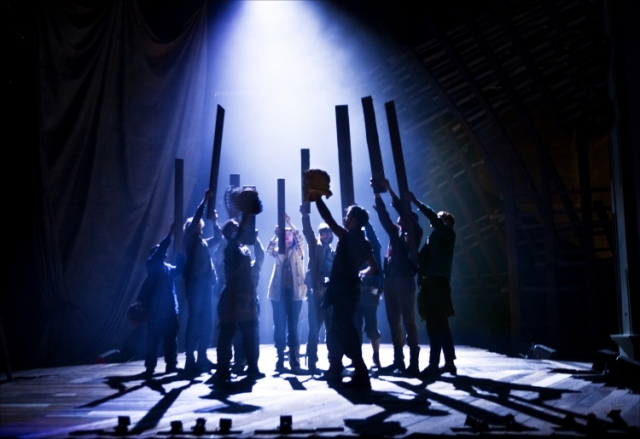By Emily Hunt
My first experience with A Midsummer Night’s Dream was watching Michael Hoffman’s 1999 film production. I’m sure the visually gorgeous cast had something to do with it – what 12-year-old girl can ignore the charms of Michelle Pfieffer, Rupert Everette, and Christian Bale? – but it was more than that: something entirely new had taken place on the screen. For the first time in my adolescent life, a work of art had induced a feeling of liberation, a distinct, excited sense of possibility.
Every production I’ve seen since has been aesthetically unique. With its magic, fight scenes, fairies, the backdrop of a seemingly opaque forest, and the changeable world of its play-within-a-play, – A Midsummer Night’s dream begs reinvention, much as its mercurial characters change while they delightfully, aimlessly wander through the woods. Nothing is definite: the four young Athenian lovers — Helena, Hermia, Demetrius, and Lysander — speak in absolutes yet are characterized by anything but. They escape into the forest in the middle of the night, where Titania, a righteous and strong fairy queen, is duped into falling in love with an ass, part of a magical revenge plot by the seemingly heartless fairy king Oberon, so touched by the unrequited love of Helena that he attempts to enchant Demetrius, her wayward lover, into returning her affections. The mischievous sprite Puck mixes everything up, and the rampant, secret love affairs that drive the foursome into the forest devolve into a brawl.
And yet, somehow, in traditional Renaissance fashion, we wind up with a wedding-and-a-marriage happy ending.
Shakespeare’s comedies often lack real consequence. The Comedy of Errors begins with a tragedy at sea that somehow leads to hilarity. In The Twelfth Night’s tale of mistaken identity, chaos reins until the very end, resolved by a wedding. While the other comedies delight in the conscious fumbling and trickery of their characters, A Midsummer Night’s Dream revels in the utter baffling of them, leaving them in a rather adorable helplessness.
The production by Bristol Old Vic in association with Handspring Puppet Company which showed at the Broad Stage in early April is intentionally spare. Directed by Tom Morris, it plays on a stage adorned with almost nothing but a painted screen, a table, and some wooden boards — boards that represent the sun, stand in for trees, and serve as weapons. The play opens on Hippolyta, played by Saska Portway, and her royal fiancé Theseus, David Ricardo-Pearce, discussing their upcoming marriage. Despite Portway’s punkish shock of blonde hair and Ricardo-Pearce’s impeccable comedic timing, they play these characters as traditional straight men. The two shine, however, when doubling as Titania and Oberon, controlling primitive masks and rudimentary wooden hands to embody the characters. Such a self-conscious and obvious physical distinction further separates the two from the mortal world. Puppets of all shapes and sizes, from an elegantly mechanical, velociraptor-looking thing to a rather frightening baby doll, took the roles of the more minor fairies. Yet perhaps most importantly and most shocking was the chaotic, makeshift “puppet” that constituted the role of Puck.
Maintained by three different actors, each controlling a different part of his body, Puck’s person was made up of a wicker basket, a dull saw, a brush, and other random and cumbersome inanimate objects. The actors Fionn Gill, Lucy Tuck, and Saikat Ahamed, each strikingly different in appearance, joined their voices and movements together in a haphazard unison: a chaotic, daring, yet satisfying choice.
Incorporating puppetry is appropriate: nearly every character in the comedy is controlled, marionette-like, by some power or another, be it magic, law, or love. Seeing Puck as a clumsy, amateurish puppet comprised of household tools, a character with no coherence, we no longer expect consistency. We are left without presumptions, truly open to the play’s inventiveness and whimsical bizarreness. The characters have no control over themselves: their tragic loves, their respect and honor, their hate, and their revenge, are all shown to be asides, each life a random arrangement that the fates and fairies may turn upside down at any moment. This is a tonic for a culture where individual autonomy, striving, and achievement are the highest virtues. Denying responsibility might be the most liberating gift art can offer. We look up at the night sky, blazing with faraway stars and fairy dust, and think that, hard as we try, our actions don’t matter much.
The impassioned meandering of the talentless troupe of players highlights this. When the self-glorifying buffoon, Bottom, his fervent delusions of grandeur given a thick accent by actor Miltos Yerolemou, is unwittingly turned into a donkey, he is hoisted onto a bicycle-like contraption, his actual bare ass adorned with donkey ears. His motley group of friends and actors flee from him, screaming their ill-fitting pants off.
Titania, however, immediately falls in love. Portway is a true slapstick comedienne: whirling about the stage, in love to the point of madness, she inches closer to Bottom’s bottom as the audience flinches. At the end of the scene, Titania embraces her lover, giving a full bear hug to a fully bare bottom. We’re in awe at Portway’s unabashed willingness to make such a commitment to her character’s less-than-appetizing obsession, but we’re not surprised: in the midst of A Midsummer Night’s Dream’s mayhem, we all feel more than happy to let ourselves go.


